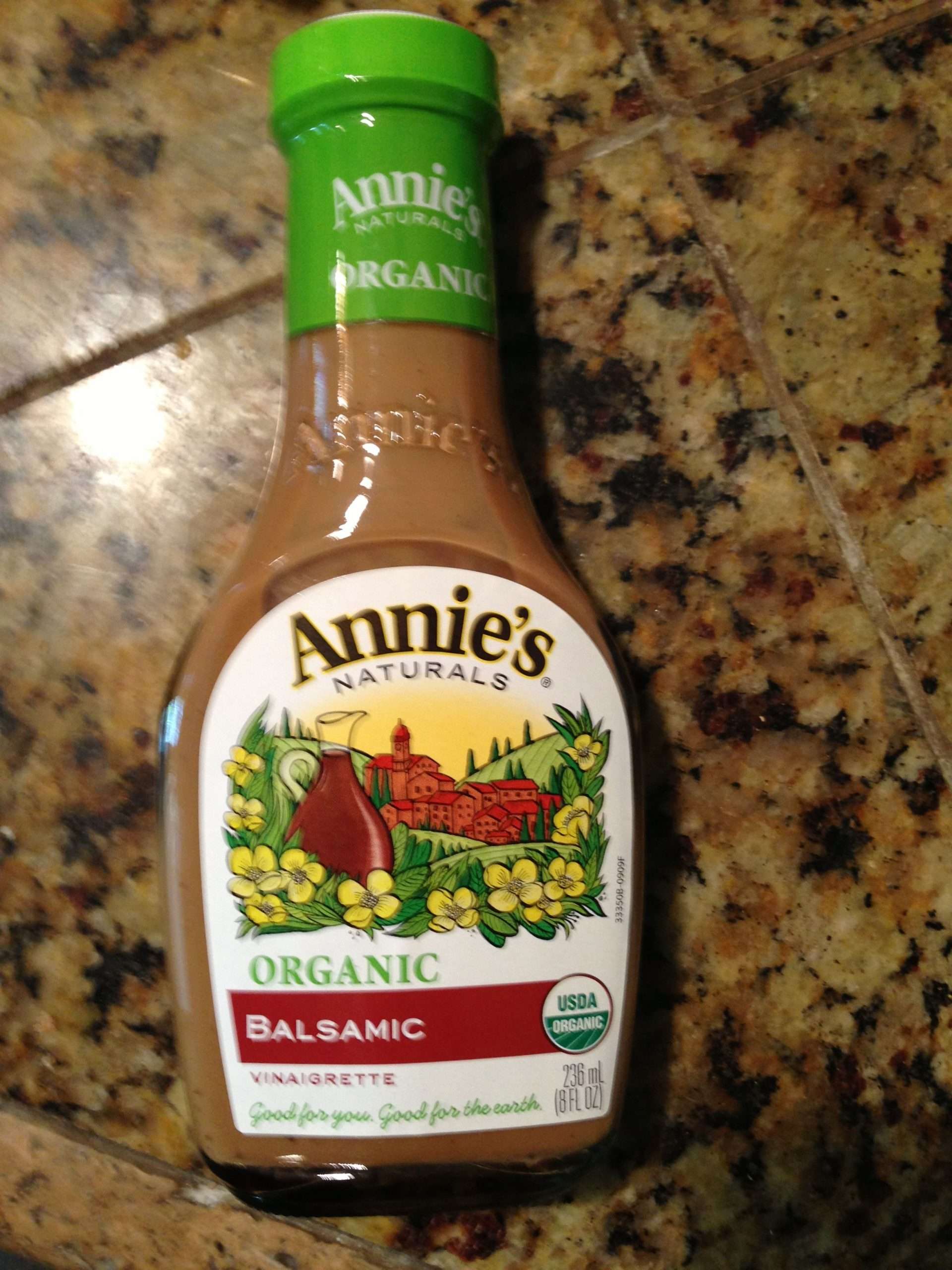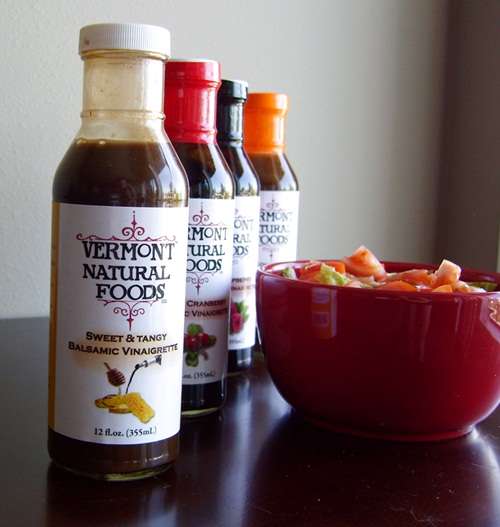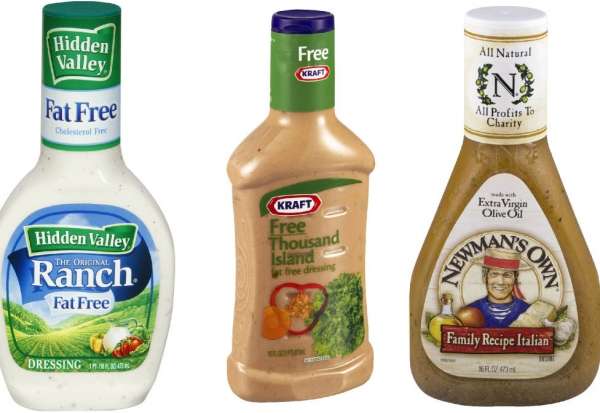Why You Might Want To Make Oil Free Salad Dressings
One of the main health benefits of a salad is a very high nutrient to calorie ratio. A pound of raw greens, for example, contains around 100 calories. For a visual, the large plastic clamshell containers of mixed greens at the supermarket weigh one pound. You would be hard-pressed to eat that entire container all at once, especially if you added some carrot shreds and sliced red onion, cucumber, and radish for variety and texture. A more realistic portion of that mixed green salad is a quarter-pound, which would, after adding in some bonus veggies, yield around 60 calories. So far, so good.
Now add your oil-based salad dressing. Lets stick to the serving size of two tablespoons just for the sake of argument. A serving of dressing thats 50% oil would, therefore, include one tablespoon of oil, which contains 120 calories. Suddenly your 60 calorie salad is now a 180 calorie salad. And two-thirds of the calories are coming from the oil in the dressing. So while your eyes can fool you into thinking that youre eating a large salad with a little bit of dressing, your metabolism is actually dealing with a large amount of dressing with a small side of salad.
Oil is theres no way around it a highly processed food. Its had all of the fiber, protein, and most of the phytonutrients removed from whatever it was made from, creating a product that is pretty far from what nature intended.
Apple Cider Vinaigrette Dressing
Get all the health benefits of apple cider vinegar with this delicious apple cider vinaigrette dressing. Drizzle over salad or use as a marinade.
When it comes to homemade salad dressings, this apple cider vinaigrette has been my go-to for the longest time.
Its super simple to make and is packed with nutrients and flavor! I use it to dress my salads all the time, but its also awesome as a .
Make Your Own Dressings
If you’ve got a few extra minutes, dressings you make yourself can be even more delicious than the store-bought kind, and you have total control over the ingredients. Here are recipes for two light salad dressings you probably won’t see on the supermarket shelf.
Japanese Restaurant Salad Dressing
Journal as: 1 teaspoon oil
1/4 cup chopped onion 2 tablespoons canola oil or peanut oil 2 1/2 tablespoons rice wine vinegar 2 tablespoons water 1 tablespoon minced fresh ginger root 2 tablespoons minced celery 2 teaspoon light soy sauce 2 teaspoons light corn syrup or honey 2 teaspoons lemon juice 1/8 teaspoon salt 1/8 teaspoon ground black pepper
- Add all the ingredients to a small food processor or blender. Pulse on high speed for about 30 seconds, or until well-pureed.
- Pour into serving container, cover, and refrigerate until needed.
Yield: 14 tablespoons
Per 2-tablespoon serving: 48 calories, 0.3 g protein, 3.1 g carbohydrate, 4 g fat, 0.3 g saturated fat, 0 mg cholesterol, 0.2 g fiber, 79 mg sodium. Calories from fat: 73%.
Roasted Red Pepper Vinaigrette
Journal as: 1 teaspoon oil
3/4 cup bottled roasted red pepper pieces, drained 2 tablespoons olive oil 2 tablespoons fat-free sour cream 2 tablespoons red wine vinegar 1 tablespoons light mayonnaise 1 tablespoon shredded Parmesan cheese 1 1/2 teaspoons minced garlic 1/2 teaspoon dried basil Salt and pepper to taste
Yield: 1 1/4 cup
Show Sources
Recommended Reading: Can You Eat Salad While Fasting
Unhealthy Fatty Acid Ratios
Many oils contain an unhealthy omega-6 to omega-3 fatty acid ratio. This fatty-acid imbalance is linked to inflammation associated with pretty much all chronic diseases. The ideal omega-6 to omega-3 ratio in the human diet is somewhere between 1:1 and 4:1. But most people eating the modern industrialized diet are getting between 10:1 and 20:1.
Oils such as safflower, sunflower, corn, cottonseed, sesame, and peanut contain no omega-3s at all and range in omega-6 content from 32-75%. Soybean oil has seven times more omega-6 fatty acids than omega-3s.
If youre going to use oil, the best options are those low in omega-6, low in saturated fats and trans fats, and high in omega-3 fatty acids. For example, flax oil, extra virgin olive oil, avocado oil, and MCT oil.
But, for all the reasons weve seen, many people want to make dressings with no oil whatsoever. Fortunately, you can do that without sacrificing flavor!
The Healthiest Salad Dressings Are The Simplest Ones

The best salad dressings are typically very simple with few ingredients, Pegah Jalali, a registered dietitian at Middleberg Nutrition, told HuffPost. You always want to focus on the first few ingredients avoid a salad dressing with ingredients that you cannot recognize like phosphoric acid, calcium disodium EDTA and artificial flavors.
Jalali lists vinegars, oils and spices found in a typical home kitchen as solid core ingredients. Her store-bought salad dressing of choice is Primal Kitchens green goddess dressing. Its made with minimal ingredients and uses health-supportive ingredients including avocado oil, it has no added sugars and is delicious, Jalali said.
Also Check: Is Tuna Salad Good For Diabetics
Delicious New Wholesome Low Fat Low Sugar And Low Sodium Salad Dressings
Alisa Fleming ~ Several years ago, I gave up purchasing salad dressing as none had ingredient lists that I felt comfortable paying for. Even many of the organic and all-natural brands use soybean oil instead of good quality oils, and seriously, what is with all of the added sweeteners? I admit to loving a little honey or maple in my salad dressings, but most brands seem a bit bombarded with sugar and salt.
Then, I received an email about new salad dressings from Vermont Natural Foods. I almost brushed it off, thinking that store bought just wouldnt measure up, but decided to take a quick peek at their website. I was thrilled with what I discovered four types of salad dressings all very low in fat, and made without sodium, gluten, soy, artificial colors or flavors, corn syrup, peanuts, tree nuts, wheat, AND dairy!
Whats left? Ingredients like extra virgin olive oil, balsamic vinegar, and real fruit. You know the things good quality salad dressings are made of
Sweet & Tangy Balsamic Vinaigrette Ingredients: Balsamic Vinegar, Water, Extra Virgin Olive Oil, Honey, Mustard, powder, Xanthan Gum
Shitake Orange-Ginger Balsamic Vinaigrette Ingredients : Balsamic Vinegar, Water, Extra Virgin Olive oil, Orange juice, Ginger Puree, Shitake Mushroom, Xanthan Gum
Maple Cranberry Balsamic Vinaigrette Ingredients : Balsamic Vinegar, Water, Extra Virgin Olive Oil, Cranberry juice, Maple Syrup, Xanthan Gum
Super Low-Fat Roasted Root Veggies
Preheat your oven to 400ºF
Healthy Honey Mustard Dressing
Honey Mustard is often filled with sugar but my version is not! It’s light, bright, and creamy thanks to the mustard and greek yogurt. My Healthy Honey Mustard Dressing does have honey but no added refined sugar.
Serve it with my Fall Harvest Salad or any other salad you’d normally like Honey Mustard with. It also works great as a dip!
Don’t Miss: Easy Red Potato Salad Recipe
Healthy Homemade Greek Salad Dressing
This classic Greek Salad Dressing is inspired by the salad at my favorite Greek restaurant. It’s made with zesty lemons and familiar greek style herbs like oregano. It has a slightly higher vinegar to olive oil ratio making it a bit lighter in taste and calories. It goes great on everything from a classic greek salad to a summer pasta salad. You can also use it as a marinade for fish, vegetables, or meat.
You can also serve this dressing with so many things including my Greek Tortellini Pasta Salad.
Consider Your Flavor Preferences
Even though many low-sodium dressings are vinaigrettes, there are plenty of flavor options. Some have fruity and sweeter flavors, such as a raspberry vinaigrette. Others have a little kick of spice to them, such as a honey mustard vinaigrette. You may also find some unique flavor combinations that contain avocado, chia seeds, and cilantro.
Others combine turmeric and lemon, while some combine classic flavors like red wine and olive oil or oil and vinegar. There are also the classic balsamic and Italian flavors. Some Italian varieties can include either extra virgin olive oil or avocado oil.
If you prefer creamy dressings, there are low-sodium options made with a Greek or standard yogurt base. Some brands also offer low-sodium Caesar, ranch, and blue cheese varieties that offer a richer flavor.
You May Like: Where Can I Get A Taco Salad
How To Serve Cilantro Dressing
The cilantro lime flavor combo lends itself well to Mexican dishes, but the options with this dressing are truly endless. Here are some ideas!
- Use it as a sauce for tacos. Try it on these tempeh tacos or grilled fish tacos.
- Use as the dressing on taco salad.
- Drizzle over a vegan burrito bowl.
- As a dressing on my avocado salad
- Use as a marinade for grilled meat, tofu, salmon or shrimp. Its so tasty on shrimp!
The Best Salad Dressing Formula
While these five salad dressing recipes give you a great variety to choose from, you can start to make your own combinations once you understand the basic formula for healthy homemade salad dressings.
Get creative with this standard formula:
Ranch is a little different because it is a creamy salad dressing rather than being oil-based. However, you make it much the same way, but the ratios change. Follow the recipe for this one and your ranch will be way better than anything you buy at the store.
Don’t Miss: How To Make Yogurt Salad Dressing
How To Make Homemade Salad Dressings
Healthy homemade salad dressings couldnt be easier! Just assemble all the ingredients for the variety of your choosing in a jar . Shake until it is all combined that’s it!
Youll want to give your dressing a good shake again before using, especially if it’s been sitting in the fridge for a bit. It’s normal for ingredients to separate but using a mason jar helps in shaking everything up easily.
Make Your Own Salad Dressing

Dressing being poored into a glass pitcher
Bottled salad dressings are my pet peeve — the majority of them are full of sodium, sugar and other preservatives. Whether you like a vinaigrette or the creamy stuff, you only need a few simple ingredients to make some yourself.
Dressing Basics
There are endless rows of bottled dressings at the grocery store. Depending on the kind, they are usually high in fat, sugar or both — and they all have too much sodium. You may think its wise to opt for the lower-calorie offerings but light and low-fat dressings often have even more sugar to make up for the lack of flavor.
To ensure you’re getting real ingredients, homemade is the way to go, but watch those portions. A vinaigrette may seem lighter but most are made predominantly from oils, which offer heart-healthy but unavoidable calories. Keep serving sizes to a tablespoon. You can store most homemade dressings in the fridge for up to a week .
A Simple Vinaigrette
Just join some sort of acid, oil and flavorings and — ta-da! — you have salad dressing! You can use vinegar or citrus juice for your acid. For oil, choose extra virgin olive oil if you want some olive flavor or canola or grapeseed oil if you want something neutral. Turn up the flavor with minced shallot or garlic, fresh or dried herbs, cumin, paprika or mustard — all those add minimal calories. Try orange juice, honey, jam or maple syrup for a touch of sweetness.
Recommended Reading: Spode Blue Room Salad Plates
The Six Biggest Changes To Make Low Sodium Caesar Dressing
- Just eliminating added salt Ive seen it up to ¾ teaspoon or 1725mg sodium per recipe.
- Removing Anchovy paste at 660-940mg sodium per tablespoon.
- Using low sodium honey mustard at 15mg per 1 teaspoon instead of Dijon mustard at 109mg per teaspoon.
- Substituting Parmigiano Reggiano Cheese which has just 30mg per tablespoon instead of regular parmesan.
- This recipe also incorporates part of my Low Sodium Mayonnaise recipe which replaces store bought mayo from many standard recipes.
- Using a low sodium Worcestershire sauce makes a difference also, eliminating 20mg sodium per teaspoon.
Check The Ingredients And Nutrition Labels
Some low-sodium salad dressings will carry the label of low sodium or less salt. However, this is not always the case. When you’re unsure of whether or not it’s really low-sodium, consider salad dressings that are naturally low in sodium due to their ingredients. Vinaigrettes that contain a base of olive oil or apple cider vinegar are examples.
Dressings made with yogurts, sesame seed oils, and avocado oils can also contain low amounts of sodium. However, the best way to check whether a salad dressing is low-sodium is to look at sodium per serving. A good benchmark is under 250 milligrams per serving.
You can also look at the list of ingredients to see if there is added salt and if these additives appear higher up in the list. Examples include silicon dioxide and tricalcium phosphate.
Also Check: Pasta Salad With Italian Dressing
Natural Flavors Artificial Flavorings And Food Colorings
And if you think that natural flavors are bad, wait until you see the laundry list of harms caused by the artificial flavorings and colorings that are allowed in the US food supply by the FDA. Some can cause cancer. And they appear to contribute to adrenal and kidney issues, as well as allergic reactions, hyperactivity, and behavioral problems in children.
The Easiest Healthy Salad Dressing
My last salad dressing is the salad dressing you can make when you really don’t have much time! This is what I do when I’m making a fast lunch just for myself and don’t have any other dressings on hand. It’s basically the perfect combination of lemon, olive oil, and vinegar over fresh greens.
to see my demonstration video to make it.
Recommended Reading: Brianna’s Organic Salad Dressing
Honey Mustard Dressing Vs Honey Mustard Sauce
Honestly, I use this recipe both ways, but the big difference is that honey mustard sauce is thicker and usually involves mayo whereas the dressing in thin enough to drizzle and includes oil.
Heres a basic formula for traditional honey mustard dressing and sauce.
- Honey mustard sauce: equal parts of honey, mustard and mayonnaise.
- Honey mustard dressing: a blend of oil, vinegar, mustard and honey.
I added a few extra ingredients to bring this recipe to the next level!
Healthy Homemade Salad Dressing
You just can’t beat the fresh flavor of a Healthy Homemade Salad Dressing. They are surprisingly simple to make and taste so much better than most bottled salad dressings. Plus you can control the ingredients and make them as healthy, sugar free, low carb, and low calorie as you’d like!
I’ve been making and posting healthy salad dressings on Running in a Skirt for years and wanted to give y’all a place where you could easily find them all in one place. In all, I’ve created 15 healthy salad dressing recipes covering a huge spectrum of tastes and cuisines. There is something for everyone!
I’ve got the basics covered like a Healthy Greek Yogurt Ranch, Healthy Greek Salad Dressing, Greek Yogurt Caesar Dressing, and Healthy Red Wine Vinaigrette. You’ll also find some unique options like an Apple Cider Vinaigrette and Creamy Thai Peanut Dressing.
In fact, I feel like this is the ultimate resource to making your own healthy homemade salad dressings!
Also Check: Wendy’s Caesar Salad Calories
Sodium In Regular Caesar Dressing
Nearly all commercial brand salad dressings and mixes are loaded with sodium. All but one top name store dressing was below 300mg sodium usually ranging anywhere from 300 to 380mg sodium per 2 tablespoons. This simple condiment can easily blow your sodium budget for an entire meal, mine being between 250-300mg per meal goal. So being Americas #2 and a dressing I use, more and more I wanted to find a way to make it lower in sodium and I did.
Most of the common foodstuffs that we use such as condiments, bread, and cheeses sometimes seem abnormally high in sodium. This is why I endeavor to create low sodium recipe versions of some of the basics that we consumed before we really cut back on sodium. Ive been able to reduce this recipe down to a low sodium version of only 44mg per two tablespoons.
And when combined with lettuce, my Low Sodium Croutons, and some sliced chicken I can make a whole meal that is perfectly within or way lower than my limits. This is what I did here, so dont make fun of my regular garden salad blend lettuce. LOL!
Why Use Mason Jars

Mason jars are perfect for making homemade salad dressings.
With them being glass, you dont have to worry about any nasty chemicals leaking into your food from unsafe plastics.
They are easy to wash and reuse. Buy a few and they will last for years! They’re also dishwasher safe.
If you buy the mason jars with a wide mouth, you can even get a utensil down in the jar!
Plus, the ring and lid seal tightly, making you confident about giving the dressing a good shake before serving.
Recommended Reading: Is Salad A Good Diet Food